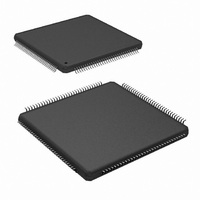ADC08D500CIYB/NOPB National Semiconductor, ADC08D500CIYB/NOPB Datasheet - Page 25

ADC08D500CIYB/NOPB
Manufacturer Part Number
ADC08D500CIYB/NOPB
Description
IC ADC 8BIT 500MSPS DUAL 128LQFP
Manufacturer
National Semiconductor
Series
PowerWise®r
Specifications of ADC08D500CIYB/NOPB
Number Of Bits
8
Sampling Rate (per Second)
500M
Data Interface
Serial
Number Of Converters
2
Power Dissipation (max)
1.78W
Voltage Supply Source
Single Supply
Operating Temperature
-40°C ~ 85°C
Mounting Type
Surface Mount
Package / Case
128-LQFP Exposed Pad
Lead Free Status / RoHS Status
Lead free / RoHS Compliant
Other names
*ADC08D500CIYB
*ADC08D500CIYB/NOPB
ADC08D500CIYB
*ADC08D500CIYB/NOPB
ADC08D500CIYB
Available stocks
Company
Part Number
Manufacturer
Quantity
Price
Company:
Part Number:
ADC08D500CIYB/NOPB
Manufacturer:
Texas Instruments
Quantity:
10 000
1.0 Functional Description
double data rate the clock frequency is half the data rate and
data is sent to the outputs on both DCLK edges. DDR
clocking is enabled in non-Extended Control mode by allow-
ing pin 4 to float.
1.1.6 The LVDS Outputs
The data outputs, the Out Of Range (OR) and DCLK, are
LVDS. Output current sources provide 3 mA of output current
to a differential 100 Ohm load when the OutV input (pin 14)
is high or 2.2 mA when the OutV input is low. For short LVDS
lines and low noise systems, satisfactory performance may
be realized with the OutV input low, which results in lower
power consumption. If the LVDS lines are long and/or the
system in which the ADC08D500 is used is noisy, it may be
necessary to tie the OutV pin high. The LVDS data output
have a typical common mode voltage of 800mV when the
V
voltage can be increased to 1.2V by tying the V
if a higher common mode is required.
IMPORTANT NOTE: Tying the V
crease the differential LVDS output voltage by upto 40mV.
1.1.7 Power Down
The ADC08D500 is in the active state when the Power Down
pin (PD) is low. When the PD pin is high, the device is in the
power down mode, where the output pins hold the last
conversion before the PD pin went high and the device
power consumption is reduced to a minimual level. A high on
the PDQ pin will power down the "Q" channel and leave the
BG
SDR or DDR Clocking
DDR Clock Phase
SDR Data transitions with rising or
falling DCLK edge
LVDS output level
Power-On Calibration Delay
Full-Scale Range
Input Offset Adjust
Dual Edge Sampling Selection
Dual Edge Sampling Input Channel
Selection
DES Sampling Clock Adjustment
pin is unconnected and floating. This common mode
Feature
BG
pin to V
Selected with pin 4
Not Selectable (0˚ Phase Only)
Selected with pin 4
Selected with pin 3
Delay Selected with pin 127
Options (650 mV
selected with pin 14. Selected range
applies to both channels.
Not possible
Enabled with pin 127
Only I-Channel Input can be used
The Clock Phase is adjusted
automatically
A
(Continued)
TABLE 2. Features and modes
BG
will also in-
pin to V
Normal Control Mode
A
P-P
25
or 870 mV
"I" channel active. There is no provision to power down the
"I" channel independently of the "Q" channel. Upon return to
normal operation, the pipeline will contain meaningless in-
formation.
If the PD input is brought high while a calibration is running,
the device will not go into power down until the calibration
sequence is complete. However, if power is applied and PD
is already high, the device will not begin the calibration
sequence until the PD input goes low. If a manual calibration
is requested while the device is powered down, the calibra-
tion will not begin at all. That is, the manual calibration input
is completely ignored in the power down state. Calibration
will function with the "Q" channel powered down, but that
channel will not be calibrated if PDQ is high. If the "Q"
channel is subsequently to be used, it is necessary to per-
form a calibration after PDQ is brought low.
1.2 NORMAL/EXTENDED CONTROL
The ADC08D500 may be operated in one of two modes. In
the simpler "normal" control mode, the user affects available
configuration and control of the device through several con-
trol pins. The "extended control mode" provides additional
configuration and control options through a serial interface
and a set of 8 registers. The two control modes are selected
with pin 14 (FSR/ECE: Extended Control Enable). The
choice of control modes is required to be a fixed selection
and is not intended to be switched dynamically while the
device is operational.
Table 2 shows how several of the device features are af-
fected by the control mode chosen.
P-P
)
Selected with DE bit in the
Configuration Register
Selected with DCP bit in the
Configuration Register. See Section
1.4
Selected with the OE bit in the
Configuration Register
Selected with the OV bit in the
Configuration Register
Short delay only.
Up to 512 step adjustments over a
nominal range of 560 mV to 840 mV.
Separate range selected for I- and
Q-Channels. Selected using registers
3H and Bh
Separate
steps for each channel using registers
2h and Ah
Enabled through DES Enable Register
Either I- or Q-Channel input may be
sampled by both ADCs
Automatic Clock Phase control can be
selected by setting bit 14 in the DES
Enable register (Dh). The clock phase
can also be adjusted manually through
the Coarse & Fine registers Eh and Fh
Extended Control Mode
±
45 mV adjustments in 512
www.national.com











